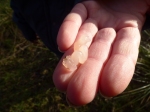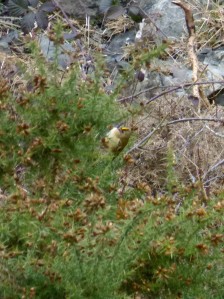Fire In My Heart
I had a rather cool evening earlier this week. Now that the evenings are both lighter and warmer, and it feels like summer is not far around the corner (with the exception of this weekend which has decided to be cold, brr!), I can start going on interesting evening adventure trips again. You may remember that I did these quite a lot when I was working in Dorset, because there was so much to explore and so much wildlife to see! And now I get to do it all over again, but this time in Cambridgeshire where there are new places to explore!
Albeit that Tuesday evening’s adventure wasn’t in Cambs. I decided to take inspiration from Bilbo Baggins by going on an adventure outside the Shire! At least, to the next one, Hertfordshire, which I can see from Wimpole Hall.
Anyway, sparked by inspiration with one of the Hall volunteers during the day, I went down to Therfield Heath near Royston (literally just over the border into Hertfordshire!) to try and find a rare flower that is currently in bloom. More on that later. After initially heading the wrong way, where I saw Bulbous Buttercup (Ranunculus bulbosus), a Meadow Pipit (Anthus pratensis) and about six Skylarks (Alauda arvensis), I found myself walking through a sun-dappled woodland.
Male Blackbirds (Turdus merula) were singing beautifully, and a Robin (Erithacus rubecula) was trilling away. And there was a high pitched noise I couldn’t identify. Up in the branches above, a tiny shape flitted back and forth. Never long enough to get a really good look, but enough to see that it was either a Goldcrest (Regulus regulus) or Firecrest (R.ignicapilla). I just needed to get a view of the face to see if there was a black eyestripe over the eye (Firecrest) or not (Goldcrest). Annoyingly, it did what small birds tend to do, and it flitted away. I dug out my phone from my pocket and looked up the Firecrest song, since my hunch was that it was a Firecrest, as I wanted to check my hunch against what I had heard.
So there was I, thinking the Firecrest had disappeared off into the trees, never to be seen again. Note to self – Firecrests have good hearing. A few moments after playing the song, and confirming my hunch, it was back. And oh my, it was in territorial mode. If it had been a human, I would say that it was in my face saying “you what, mate?”. I feel really bad for having played the song now, and affected its behaviour, particularly as this was during breeding season. I have learnt my lesson! I did manage to get a few photos before it flew off again to search for another (real) Firecrest. I also got a number of blurred or empty photos!
Continuing through the woodland, with a melodious background noise of Song Thrush (Turdus philomelos) and Chiffchaff (Phylloscopus collybita), I emerged out on the top of a hill in full sunlight. A small note that I was thrilled, as Cambridgeshire is ever so flat and I have been missing the hills of Dorset and Radnorshire! The hillside was dotted with butter-coloured Cowslips (Primula veris) and flowers of a deeper purple, the aforementioned endangered species. The rare and beautiful Pasqueflowers (Pulsatilla vulgaris), although they aren’t so rare on this particular hillside! There were loads of them! It was almost a carpet of flowers.
Aren’t they just stunning?!
I especially love the hairs on the stalk and sepals, and I did some reading up on them – the Wildlife Trusts species explorer page on the Pasqueflower has some interesting, and succinct, information on them.













































































































































































































































































































